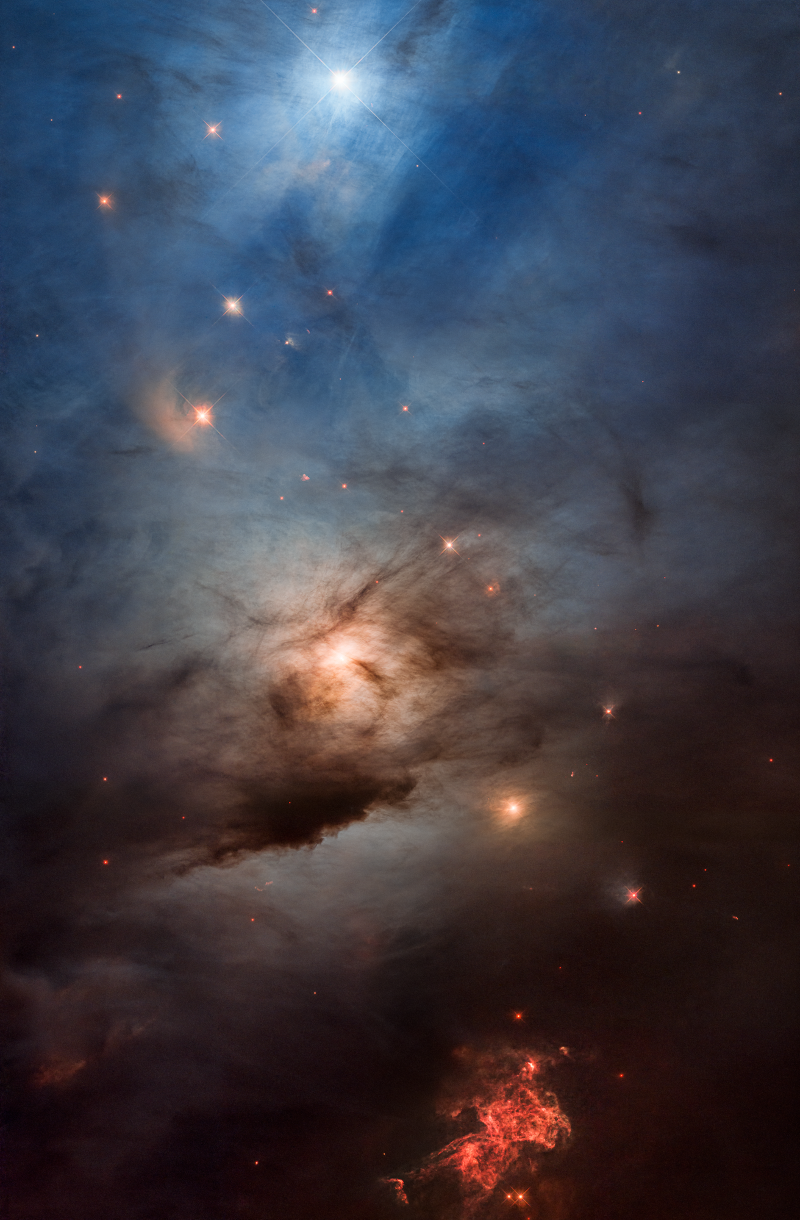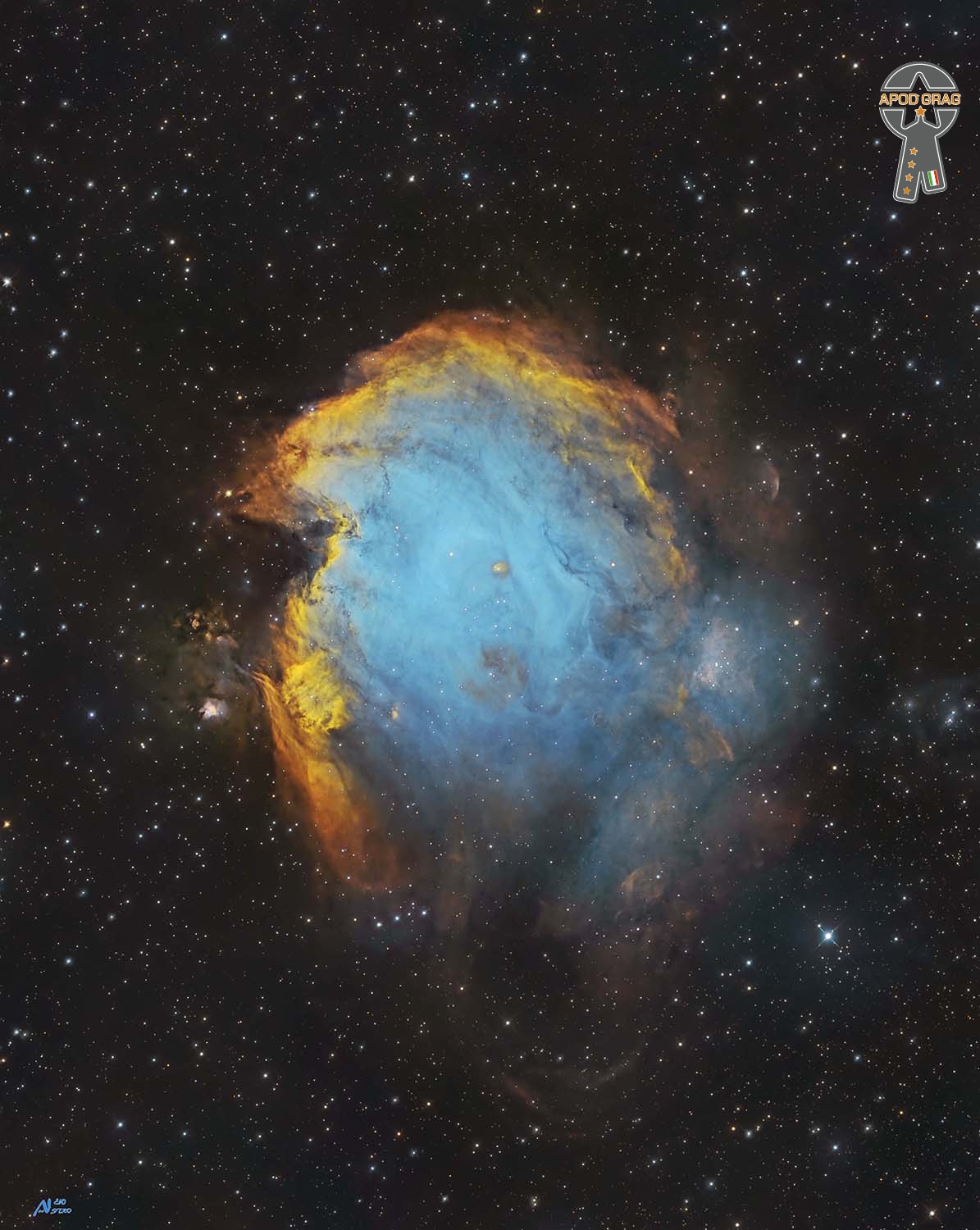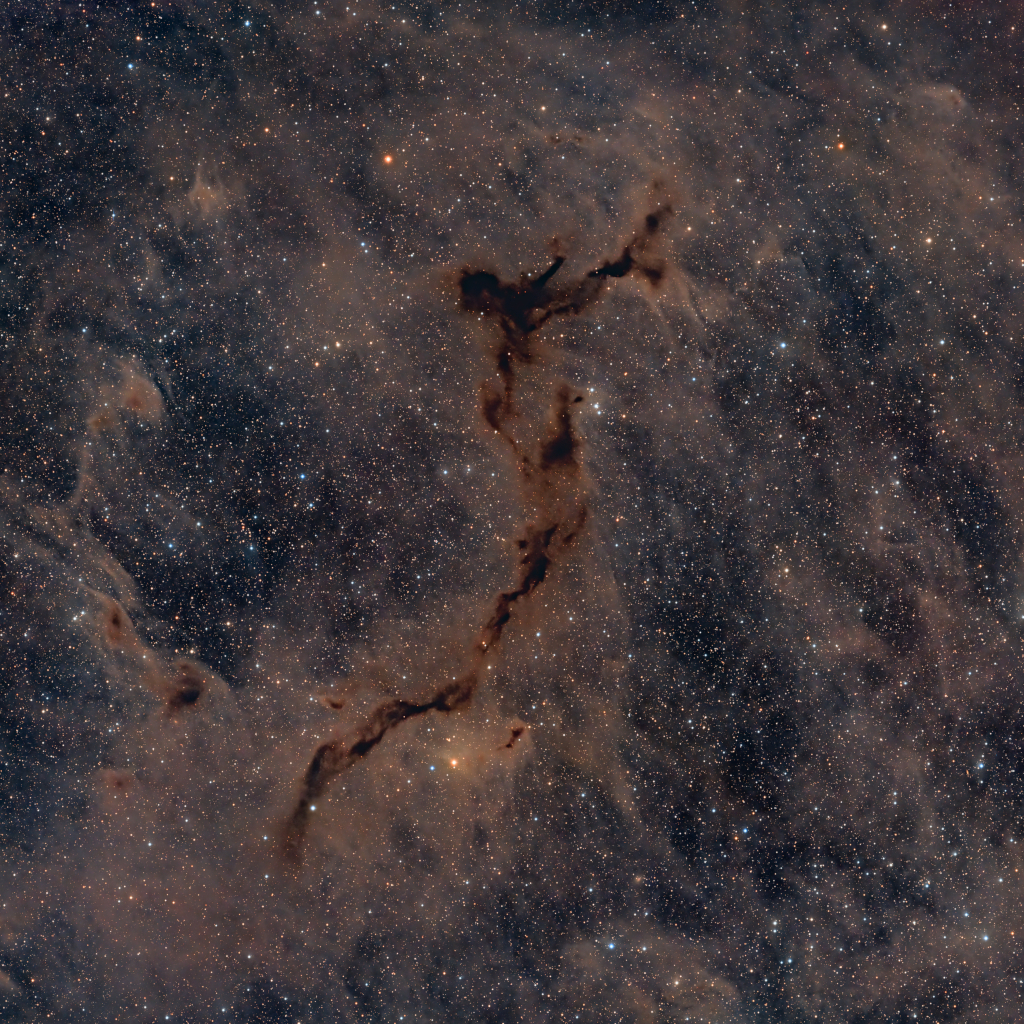Blog
In visible light NGC 1333 is seen as a reflection nebula, dominated by bluish hues characteristic of starlight reflected by interstellar dust. A mere 1,000 light-years distant toward the heroic constellationPerseus, it lies at the edge of a large, star-forming molecular cloud. This Hubble Space Telescope close-up frames a region just over 1 light-year wide at the estimated distance of NGC 1333. It shows details of the dusty region along with telltale hints of contrasty red emission from Herbig-Haro objects, jets and shocked glowing gas emanating from recently formed stars. In fact, NGC 1333 contains hundreds of stars less than a million years old, most still hidden from optical telescopes by the pervasive stardust. The chaotic environment may be similar to one in which our own Sun formed over 4.5 billion years ago. Hubble’s stunning image of the stellar nursery was released to celebrate the 33rd anniversary of the space telescope’s launch.

Rajae Belmlih, also spelled Raja Belmalih (Arabic: رجاء بلمليح; 22 April 1962 – 2 September 2007), was a Moroccan-Emirati singer. Belmlih’s career began with the Moroccan talent show, Mawahib. Her first major hit in the Arab World was Ya-Jara Wadina in 1986. The young Rajae, a University undergraduate at the time, decided to sing her first hit song at her Hassan II campus in front of her fellow students prior to the official premiere that same day.
She later settled and worked from Cairo, Egypt while continuing her studies in Arabic literature and Philosophy at Mohamed V University in Rabat. She graduated in 1995 and enrolled for a doctorate. Belmlih was named a UNESCO Goodwill Ambassador in 1999 for her numerous actions in favour of charities within the Arab world.
more...Bernard Alfred “Jack” Nitzsche April 22, 1937 – August 25, 2000) was an American musician, arranger, songwriter, composer, and record producer. He first came to prominence in the early 1960s as the right-hand-man of producer Phil Spector, and went on to work with the Rolling Stones and Neil Young, among others. He also worked extensively in film scores, notably for the films Performance, The Exorcist and One Flew Over the Cuckoo’s Nest. In 1983, he won the Academy Award for Best Original Songfor co-writing “Up Where We Belong” with Buffy Sainte-Marie.
Nitzsche was born in Chicago and raised on a farm in Newaygo, Michigan, the son of German immigrants. He moved to Los Angeles in 1955 with ambitions of becoming a jazz saxophonist. He was hired by Sonny Bono, who was at the time an A&R executive at Specialty Records, as a music copyist. While there, Nitzsche wrote a novelty hit titled “Bongo Bongo Bongo”. Nitzsche wrote with Bono the song “Needles and Pins” for Jackie DeShannon, later recorded by the Searchers. His instrumental composition “The Lonely Surfer”entered the Cash Box top 100 on August 3, 1963, and reached No. 37.
more...Paul Laurence Dunbar Chambers Jr. (April 22, 1935 – January 4, 1969) was an American jazz double bassist. A fixture of rhythm sections during the 1950s and 1960s, he has become one of the most widely-known jazz bassists of the hard bop era. He was also known for his bowed solos. Chambers recorded about a dozen albums as a leader or co-leader, and over 100 more as a sideman, especially as the anchor of trumpeter Miles Davis‘s “first great quintet” (1955–63) and with pianist Wynton Kelly (1963–68).
Born in Pittsburgh, Pennsylvania, on April 22, 1935, to Paul Lawrence Chambers and Margaret Echos. He was brought up in Detroit, Michigan, following the death of his mother. He began playing music with several of his schoolmates on the baritone horn. Later he took up the tuba. “I got along pretty well, but it’s quite a job to carry it around in those long parades, and I didn’t like the instrument that much”. During the course of his lifetime Paul Chambers developed addictions to both alcohol and heroin. He was hospitalized at the end of 1968 with what was thought to be a severe case of influenza, but tests revealed that he had tuberculosis. As his organ functions deteriorated, Chambers lapsed into a coma for 18 days. It is believed that his addictions to heroin and alcohol contributed to his health problems. On January 4, 1969, he died of tuberculosis aged 33.
more...Charles Mingus Jr. (April 22, 1922 – January 5, 1979) was an American jazz upright bassist, pianist, composer, bandleader, and author. A major proponent of collective improvisation, he is considered to be one of the greatest jazz musicians and composers in history, with a career spanning three decades and collaborations with other jazz musicians such as Louis Armstrong, Duke Ellington, Charlie Parker, Dizzy Gillespie, and Herbie Hancock. Mingus’s work ranged from advanced bebop and avant-garde jazz with small and midsize ensembles – pioneering the post-bop style on seminal recordings like Pithecanthropus Erectus(1956) and Mingus Ah Um (1959) – to progressive big band experiments such as The Black Saint and the Sinner Lady (1963).
Mingus’s compositions continue to be played by contemporary musicians ranging from the repertory bands Mingus Big Band, Mingus Dynasty, and Mingus Orchestra, to the high school students who play the charts and compete in the Charles Mingus High School Competition. In 1993, the Library of Congress acquired Mingus’s collected papers—including scores, sound recordings, correspondence and photos—in what they described as “the most important acquisition of a manuscript collection relating to jazz in the Library’s history”.
Charles Mingus was born in Nogales, Arizona. His father, Charles Mingus Sr., was a sergeant in the U.S. Army. Mingus Junior was largely raised in the Watts area of Los Angeles. His maternal grandfather was a Chinese British subject from Hong Kong, and his maternal grandmother was an African-American from the southern United States. Mingus was the great-great-great-grandson of the family’s founding patriarch who was, by most accounts, a German immigrant. His ancestry included German American, African American, and Native American.
more...Shabbat for the Soul at Mt Zion Temple in St Paul 630pm performing with Cantor Jennifer Strauss-Klein.
more...NGC 2174 (also known as Monkey Head Nebula) is an H II emission nebula located in the constellation Orion and is associated with the open star cluster NGC 2175. It is thought to be located about 6,400 light-years away from Earth. The nebula may have formed through hierarchical collapse.
There is some equivocation in the use of the identifiers NGC 2174 and NGC 2175. These may apply to the entire nebula, to its brightest knot, or to the star cluster it includes. Burnham’s Celestial Handbook lists the entire nebula as 2174/2175 and does not mention the star cluster. The NGC Project (working from the original descriptive notes) assigns NGC 2174 to the prominent knot at J2000 06h 09m 23.7s, +20° 39′ 34″ and NGC 2175 to the entire nebula, and by extension to the star cluster. Simbad uses NGC 2174 for the nebula and NGC 2175 for the star cluster.
Glowing gas and dark dust do not survive well in the Monkey Head Nebula. Young stars near the center of the nebula generate stellar winds and high energy radiation that causes the nebula’s material to shift into complex shapes. The nebula is primarily composed of hydrogen which glows at infrared wavelengths due to the radiation.

Bobby McClure (April 21, 1942 – November 13, 1992) was an American soul singer.
McClure was born in Chicago, Illinois. By the age of two his family had moved to St. Louis, where he sang in church and gospel groups in his youth. He sang with The Soul Stirrers (then led by Sam Cooke) in the 1950s, and moved into secular music soon after, singing with Bobby & the Vocals, Big Daddy Jenkins, and Oliver Sain. McClure, who recorded for Checker, a subsidiary of Chess Records, scored two hit singles in the U.S. in 1965, and thereafter helped launch the careers of Little Milton and Fontella Bass; during this time he also played with Otis Clay and Shirley Brown. “Peak of Love” was a soul hit in late 1966, however it barely scraped the pop charts.
McClure moved on from music in the 1970s, working in an Illinois jail as a corrections officer, though he recorded some singles in the 1980s. McClure suffered a brain aneurysm in 1992, and died in Los Angeles, California, of complications from a stroke soon after.
more...Alfred James Ellis (April 21, 1941 – September 23, 2021), known as Pee Wee Ellis due to his diminutive stature, was an American saxophonist, composer, and arranger. With a background in jazz, he was a member of James Brown‘s band in the 1960s, appearing on many of Brown’s recordings and co-writing hits like “Cold Sweat” and “Say It Loud – I’m Black and I’m Proud“. He also worked with Van Morrison.
In the 2014 biographical movie Get on Up about James Brown, Ellis is played by Tariq Trotter. Ellis resided in England for the last 30 years of his life. Ellis was born on April 21, 1941 in Bradenton, Florida to his mother Elizabeth and his father Garfield Devoe Rogers, Jr. His father left when he was a young boy, and In 1949, his mother married Ezell Ellis, an organizer of musicians for local dance bands.
more...Locksley Wellington Hampton (April 21, 1932 – November 18, 2021) was an American jazz trombonist, composer and arranger. As his nickname implies, Hampton’s main instrument was slide trombone, but he also occasionally played tuba and flugelhorn.
Locksley Wellington Hampton was born on April 21, 1932, in Jeannette, Pennsylvania. Laura and Clarke “Deacon” Hampton raised 12 children, taught them how to play musical instruments and set out with them as a family band. The family first came to Indianapolis in 1938. The Hamptons were a very musical family in which mother, father, eight brothers, and four sisters, all played instruments.
more...James Mundell Lowe (April 21, 1922 – December 2, 2017) was an American jazz guitarist who worked often in radio, television, and film, and as a session musician.
He produced film and TV scores in the 1970s, such as the Billy Jack soundtrack and music for Starsky and Hutch, and worked with André Previn‘s Trio in the 1990s.
The son of a Baptist minister, Lowe grew up on a farm in Shady Grove, Smith County, Mississippi (near Laurel). He started playing guitar when he was eight years old, with his father and sister acting as his first teachers.
more...Reflecting its origin as a remate to the soleares, the underlying form of bulerías is simple. Bulerías cantes consist of three or four eight-syllable lines, and there is great flexibility in the way artists choose to treat those three or four lines. The singer may give one or two compáses to each line, or they can stretch them out, decorating each syllable with melismatic flourishes, or repeating them for rhythmic or emotional effect.
The guitarist follows the singer’s phrasing, underscoring the implied harmony, adding falsetas and maintaining the rhythmic pulse. Performing without a singer, a guitarist will string together a series of falsetas in a way that may imitate the form of letras.
A dancer will usually dance while the letra is being sung, and also dance between letras. A dancer can also dance during short breaks within the letras (a respira for the singer; a remate for the dancer). A dancer will use transitional phrases, including palmas en contra tiempo, remates and llamadas, and desplante llamadas to move from one section of the dance to another, cueing the musicians at each transition.
There are distinctive differences in dance styles for the bulerías depending on where and when the dance is performed. If it is a professional performance at a concert or theatrical show, the dancer will include 1 to 2 letras, add an escobilla, and perform an ornate traveling exit, the salida (also often called the cierre). If the dancer is performing bulerías at a flamenco party (juerga), small event, or with family and friends, the dance takes on a more personal touch that may or may not include all of the above named sections. See below for a more detailed description of each section of the dance.
more...Spanning light-years, this suggestive shape known as the Seahorse Nebula appears in silhouette against a rich, luminous background of stars. Seen toward the royal northern constellation of Cepheus, the dusty, obscuring clouds are part of a Milky Way molecular cloud some 1,200 light-years distant. It is also listed as Barnard 150 (B150), one of 182 dark markings of the sky cataloged in the early 20th century by astronomer E. E. Barnard. Packs of low mass stars are forming within, but their collapsing cores are only visible at long infrared wavelengths. Still, the colorful stars of Cepheus add to this pretty, galactic skyscape.

Stephen Robert Nesta Marley (born April 20, 1972) is a Jamaican-American musician. The son of Bob Marley, Marley is an eight-time Grammy Award winner, three times as a solo artist, twice as a producer of younger brother Damian Marley‘s Halfway Tree and Welcome to Jamrock albums, and a further three times as a member of his older brother Ziggy Marley‘s group Ziggy Marley & The Melody Makers.
Marley’s 2011 album Revelation Pt. 1 – The Root of Life won the Grammy Award for Best Reggae Album in 2012. His follow-up, Revelation Pt. 2 – The Fruit of Life, was released on July 22, 2016.
In several of his self-produced solo albums Mind Control (2007), Mind Control Acoustic (2008), Revelation Part I: The Root of Life (2011) and Revelation Part II: The Fruit of Life (2016) he has composed and produced all the songs on his album, and he has played a variety of the musical instruments himself.
more...More Posts
- Nothando Zulu doesn’t separate the artist from the community
- Chris Johnson: He Gets Paid by the Rest
- Johnna Morrow: Survival Through Diversification
- Kevin Washington: Jumping Out of the Box
- Milo Fine: Composing in Real Time
- Homewood Studios: You Do Not Have to Leave the Community to Find Great Art
- David Harris: Music Builds Community
- Jamie Carter: Music is a Reflection of Life
- Merlin Brunkow-Bronco Keeps on Playing
- Scott Nieman-Music Brings People Together Locally and Globally
- KARIBUNI
- Maqam
- Ancestor Energy
- Maroons
- Mojo Roots
- Voices of Sepharad
- Beau Koo Jacks
- World Cafe International
- Mojo Roots: Prakriti’s Kiss
- Ancestor Energy: Allwhere
